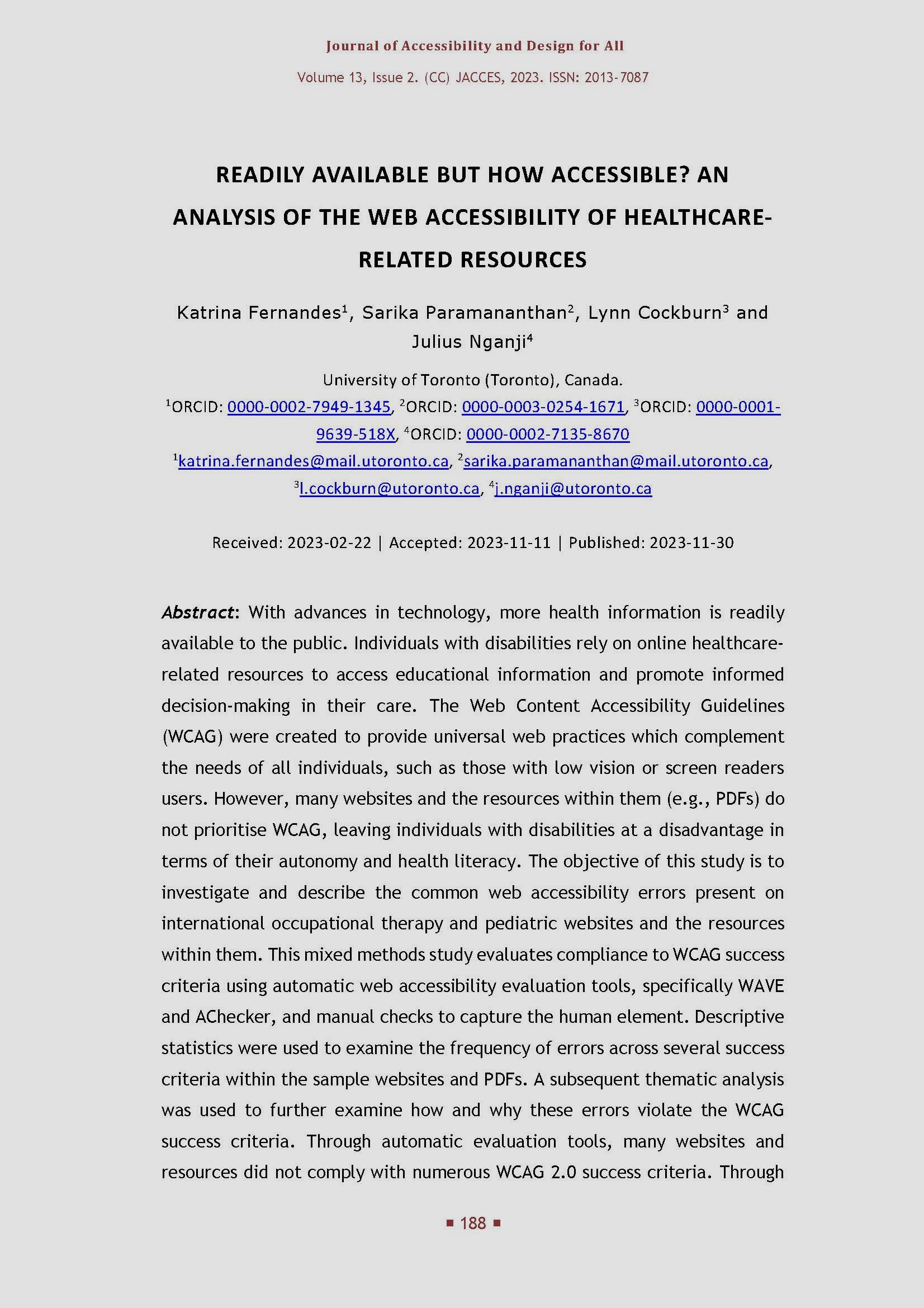Readily available but how accessible?
DOI:
https://doi.org/10.17411/jacces.v13i2.421Abstract
With advances in technology, more health information is readily available to the public. Individuals with disabilities rely on online healthcare-related resources to access educational information and promote informed decision-making in their care. The Web Content Accessibility Guidelines (WCAG) were created to provide universal web practices which complement the needs of all individuals, such as those with low vision or screen readers users. However, many websites and the resources within them (e.g., PDFs) do not prioritise WCAG, leaving individuals with disabilities at a disadvantage in terms of their autonomy and health literacy. The objective of this study is to investigate and describe the common web accessibility errors present on international occupational therapy and pediatric websites and the resources within them. This mixed methods study evaluates compliance to WCAG success criteria using automatic web accessibility evaluation tools, specifically WAVE and AChecker, and manual checks to capture the human element. Descriptive statistics were used to examine the frequency of errors across several success criteria within the sample websites and PDFs. A subsequent thematic analysis was used to further examine how and why these errors violate the WCAG success criteria. Through automatic evaluation tools, many websites and resources did not comply with numerous WCAG 2.0 success criteria. Through manual checks of the web pages and resources within them, 5 themes were identified: inaccessible images, challenges accessing additional resources, poor structural formatting, lack of tagging in PDFs, and minimal colour contrast. The results of this study can inform web developers and contributors (e.g., Occupational Therapists) on how to successfully produce accessible websites and PDFs to provide equal access to health information. In conclusion, this study adds to the current understanding that many public-facing websites and the resources within them (e.g., PDFs) are not accessible, including healthcare-related websites meant to support informed decision-making among individuals with disabilities.References
Acosta-Vargas, P., Hidalgo, P., Acosta-Vargas, G., Gonzalez, M., Guaña-Moya, J., & Salvador-Acosta, B. (2020). Challenges and Improvements in Website Accessibility for Health Services. Intelligent Human Systems Integration. (pp. 875–881). Springer International Publishing. https://doi.org/10.1007/978-3-030-39512-4_134
AChecker Web Accessibility Checker. (2018). AChecker. Retrieved from https://achecker.achecks.ca/checker/index.php
Alajarmeh, N. (2021). Evaluating the accessibility of public health websites: An exploratory cross-country study. Universal Access in the Information Society, 1–19. https://doi.org/10.1007/s10209-020-00788-7
Braun, & Clarke, V. (2006). Using thematic analysis in psychology. Qualitative Research in Psychology, 3(2), 77–101. https://doi.org/10.1191/1478088706qp063oa
Henry, S. (2019). Introduction to Web Accessibility. Web Accessibility Initiative.https://www.w3.org/WAI/fundamentals/accessibility-intro/
Mackenzie, L., Coppola, S., Alvarez, L., Cibule, L., Maltsev, S., Loh, S. Y., Mlambo, T.,Ikiugu, M. N., Pihlar, Z., Sriphetcharawut, S.,Baptiste, S., & Ledgerd, R. (2017). International Occupational Therapy Research Priorities: A Delphi Study. OTJR (Thorofare, N.J.), 37(2), 72–81. https://doi.org/ 10.1177/1539449216687528
Mason, A. M., Compton, J., & Bhati, S. (2021). Disabilities and the digital divide: Assessing web accessibility, readability, and mobility of popular health websites. Journal of Health Communication, 26(10), 667–674. https://doi.org/10.1080/10810730.2021.1987591
Mueller, M. Jolly, R. Eggert, E. (2018). Web Accessibility Laws & Policies. Web Accessibility Initiative. https://www.w3.org/WAI/policies/
Nganji, J. (2015). The Portable Document Format (PDF) accessibility practice of four journal publishers. Library & Information Science Research, 37(3), 254–262. https://doi.org/10.1016/j.lisr.2015.02.002
Schmutz, S., Sonderegger, A., & Sauer, J. (2016). Implementing Recommendations From Web Accessibility Guidelines: Would They Also Provide Benefits to Nondisabled Users. Human Factors, 58(4), 611–629. https://doi.org/10.1177/0018720816640962
Sik-Lanyi, C., & Orbán-Mihálykó, É. (2019). Accessibility testing of European health-related websites. Arabian Journal for Science and Engineering, 44(11), 9171–9190. https://doi.org/10.1007/s13369-019-04017-z
UsableNet. (2021). We do it for you. https://usablenet.com/technology/assistive-technology-services
Vigo, M., Brown, J., & Conway, V. (2013). Benchmarking web accessibility evaluation tools: measuring the harm of sole reliance on automated tests. Proceedings of the 10th International Cross-Disciplinary Conference on Web Accessibility, 1–10. https://doi.org/10.1145/2461121.2461124
W3C (2023a) What We're Working On https://www.w3.org/WAI/update/
W3C. (2023b). Understanding success criterion 1.4.4: Resize text. https://www.w3.org/WAI/WCAG21/Understanding/resize-text.html
W3C. (2018). How to Meet WCAG (Quick Reference). Web Accessibility Initiative. https://www.w3.org/WAI/WCAG21/quickref/#abbreviations
W3C. (2021). Evaluating Web Accessibility Overview. https://www.w3.org/WAI/test-evaluate/
Wagner, L. (2021). Disabled People in the World in 2019: Facts and Figures. InclusiveCity Maker. https://www.inclusivecitymaker.com/disabled-people-in-the-world-in-2021-facts-and-figures/
WebAIM. (2023). WAVE Web Accessibility Evaluation Tool. https://wave.webaim.org/
Wordpress.com Support, (n.d.). Accessibility. Retrieved from https://wordpress.com/support/accessibility
Yi, Y. J. (2018). Web accessibility of healthcare websites of Korean government and Public Agencies: A user test for persons with visual impairment. Universal Access in the Information Society, 19(1), 41–56. https://doi.org/10.1007/s10209-018-0625-5

Downloads
Published
How to Cite
Issue
Section
License
Copyright (c) 2023 Katrina Fernandes, Sarika Paramananthan, Lynn Cockburn, Julius Nganji

This work is licensed under a Creative Commons Attribution-NonCommercial 4.0 International License.
- Authors retain copyright and grant the journal right of first publication with the work simultaneously licensed under a Creative Commons Attribution License that allows others to share or adapt the work with an acknowledgment of the work's authorship and initial publication in this journal. Use of the work for commercial purposes are not allowed.
- Authors are able to publish the journal's published version of the work in other media (e.g., post it to an institutional repository or publish it in a book), as far as they inform the Journal of Accessibility and Design for All of that fact. When publishing their work in other sources, authors must mention the name of the Journal of Accessibility and Design for All, its ISSN, the number and issue in which the article was published and a link to the main page of the Journal of Accessibility and Design for All. Optionally, they can also include a link to the article published in the Journal of Accessibility and Design for All.
- Authors are permitted and encouraged to post their work online (e.g., in institutional repositories or on their website), as it can lead to productive exchanges, as well as earlier and greater citation of published work.



